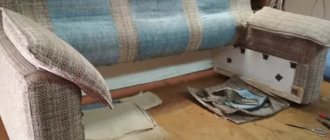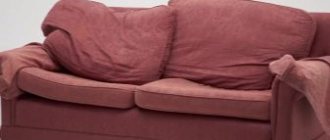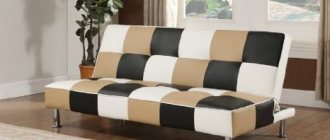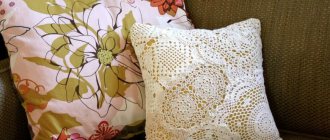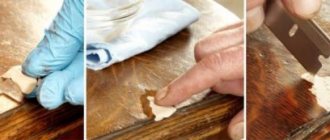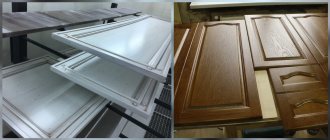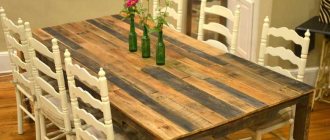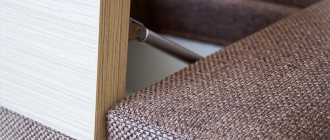Repairing a sofa with your own hands is not as difficult as it seems at first glance. Even high-quality upholstered furniture becomes unusable after a while, because the springs are often deformed, and the wood frame can crack due to heavy loads. Yes, you can buy a new sofa, but such a purchase can significantly affect your budget. But don’t despair, because many damages can be corrected by repairing and reupholstering the sofa.
DIY sofa repair
How to recover?
Restoring an old sofa with your own hands at home is a process that requires a comfortable workspace for the master.
If you start restoring a Soviet sofa, most likely you will have to change a lot. An antique sofa has even more problems dictated by time. Therefore, from a financial point of view, purchasing a new sofa may be a more reasonable action. But if we are talking about assembling furniture that has value, is heirloom or rare, if you want to update, for example, a Stalinist sofa, the work is worth it. And even at home, and not in a special room, you can achieve success. This applies to a corner sofa, a bench sofa, and a wooden one. You can solve this problem yourself, but using a certain algorithm.
Disassembly
Furniture restoration always begins with disassembly. This means that you need to unscrew and remove the locks, unfasten the old staples that previously secured the upholstery to the frame. At this point, keep garbage bags nearby so as not to waste time cleaning the room later.
In fact, this stage is also a kind of diagnostic. Having disassembled the furniture structure, you will see what is inside the sofa, how intact it is, what needs to be changed, and what is not necessary.
Replacing old elements
This is the main and rather labor-intensive stage. Direct repair with replacement of old elements. If, for example, you see cracks on the frame beams, you cannot ignore this. You find solid beams and put them in place of the deformed ones. In this case, the sofa will serve for a long time, and it will no longer be dented.
To secure the new parts, use nails or a pneumatic stapler. If the spring block has become unusable, it also needs to be replaced with a new, durable one suitable for this model of sofa.
Replacing the filler is also required. Usually foam rubber is used for this purpose. Remove the old one, carefully insert the new one in its place. The next step is to replace the locks.
Upholstery or upholstery replacement
This, one might say, is the most creative stage of work. Before purchasing new fabric, measure the old one (already removed by this time). Add a margin of at least 50 cm to it, so you will leave enough space for turns. The purchased material should be cut into individual elements. Let the old upholstery become the pattern, just shake it out thoroughly first.
Don't forget to leave allowances. If you are sewing your own cover, you will need a good sewing machine with an overlocker. If there is none, you will have to contact specialists. Before fastening, sewn covers must be tried on. It is possible that at this stage it turns out that they will have to be trimmed or sutured. The upholstery is secured to the frame using a furniture stapler with staples. The standard interval between staples is 40-45 cm.
Remember that, for example, striped fabric should be cut in one direction. Of course, fabric costs will increase, and you should know this before purchasing.
What is the structure of the sofa made of?
Before you begin the repair, you need to familiarize yourself with the elements that make up the design of the sofa:
- A wooden frame, which also consists of plywood parts. It is worth noting that a plywood base will be more reliable, but it is much more difficult to manufacture, so pine bars are often used to create the frame, connecting them together with wood glue.
sofa frame - Base for spring block. In this case, the base can be a type of lamellas (cross bars) or fiberboard. The first option is usually installed in more expensive sofa models. Thus, the lamellas in all modern products are fixed to plastic stops, which quickly fail. In addition, they can also become deformed, because in order to reduce the cost of the sofa, manufacturers often lay them with too large a gap, which does not meet the standards. Over time, due to such negligence, holes form in the seat.
- Spring block. Springs also differ from each other; they can be dependent or independent types. The second option will be more comfortable, but correspondingly more expensive. Spring block
- Dense material (felt is often used), thanks to which the springs do not deform the foam.
- Foam rubber. In the process of making sofas, dense, furniture-grade foam is usually used. Accordingly, the greater its thickness, the more expensive the product will be. You can independently increase the thickness of the foam rubber only if you do not have a folding structure in front of you.
- Sintepon, which is fixed on top of the foam rubber with glue. This is necessary so that the upholstery does not rub the soft part.
- Upholstery. The upholstery material can be different, and if it needs to be replaced, it is important to choose an option that is suitable in terms of density.
The sofa consists of much larger elements than one might expect.
If we are talking about a folding sofa, then the design also includes a transformation mechanism. There are several types of such mechanisms, and we will tell you more about the most popular ones in the table.
Table 1. Types of transformation mechanisms
| Type, illustration | Description |
| Click-clack | Such a mechanism assumes the presence of three provisions. It is often installed on modern types of sofas with slats. |
| Meralax | Thanks to the installation of such a mechanism, you can achieve a massage effect when sitting or lying down. Meralax can be metal or in the form of wooden planks. |
| Dolphin | This is not a bulky, but at the same time very convenient to use mechanism. A seat is fixed to the side of the frame, which will then move apart. This is the simplest mechanism of all existing options, but at the same time it is reliable. |
| Accordion | This mechanism also suggests the presence of three folding options. Its main part is static, others move and are fixed with locks. The accordion is installed in various modern products; it cannot be found in old furniture. |
Types of sofa mechanisms
The best means for cleaning a sofa, folk recipes.
Various mechanisms are installed inside the furniture. In some models, the additional part rolls out from under the seat, in others the backrest is moved to a horizontal position.
There are several mechanisms for laying out sofas.
But regardless of the design of the structure, you will need the same set of tools to repair it:
- wrenches to disassemble the body;
- screwdrivers, screwdriver to remove some parts;
- machine oil or silicone grease for processing the mechanism;
- staples and stapler;
- drill with a set of drills.
Let's take a closer look at popular sofa mechanisms.
Click-clack
A type of “book”. The base is a metal frame. Some models are equipped with an armrest adjustment mechanism.
The most popular sofas with a book mechanism.
The sofa can be installed in 3 different positions: sitting, reclining and lying down. The armrests are suitable for use as pillows.
The most modern type for serial models of upholstered furniture.
Often “click-clack” sofas are equipped with built-in drawers for storing things. The mechanism requires regular lubrication of rivets and rubbing elements.
Meralax
The mechanism works on the “French clamshell” principle. Can take three positions. The sleeping area can be decorated with slats or metal mesh.
The popularity of the Meralax mechanism is associated with its simplicity and low cost of execution.
Dolphin
It is based on a mechanism consisting of rollers and guides. The additional part is located under the seat and extends when you pull on a loop. One of the most popular and simple types of folding sofas.
Dolphin sofas are quite popular in our market.
In budget models, the frame is made of low quality metal, which can cause the mechanism to fail.
Accordion
One of the most popular mechanisms in folding sofas. The furniture can be taken in three positions, one part always remains motionless. The layout positions are fixed with locks.
Unfolding and fixing occurs due to movable axes and locks.
The mechanism is often used in modern models.
Repair tools and materials
Repairing a leather sofa, regardless of the degree of damage, involves its complete or partial disassembly and subsequent restoration to its original condition after replacing faulty parts.
To do this you will need
tools :
- screwdrivers;
- spanners;
- pliers;
- stapler, staples;
- hammer;
- small brush;
- sewing machine;
- scissors, stationery knife;
- square, tape measure, marker:
- wood saw;
- gloves.
List of materials :
- glue;
- stain;
- impregnation for wood;
- foam;
- upholstery;
- lining fabric;
- varnish or paint for the armrest.
The process will be accompanied by copious amounts of dust, so it is advisable to stock up on mounting film to protect interior items from contamination.
Advantages and disadvantages of restoration
DIY sofa repair: fixing common problems
All the advantages boil down to the following:
- The family budget is significantly saved. This is the main advantage, since repairs are always cheaper than buying a new thing.
- Preservation of antiques. Antique items have good prices. But if they have visible defects, then the price drops significantly. Therefore, it is better to update them before selling them.
- It's easy to choose the right color scheme. It is always easier to buy fabric in the right color than to buy a ready-made item.
- Replacing the material with a higher quality one. If you are not short on money, you can turn an old sofa into an exclusive item.
- Knowing the weak points of the structure, you can eliminate these problems by reliably strengthening the parts.
Restoring a sofa with your own hands has many advantages.
We can say that there are no cons at all. Well, except for one thing. Instead of a new sofa, you will have to use the old one.
Restoring a sofa that has lost its attractive appearance is not only economically beneficial. At the same time, various opportunities open up, both to use a thing dear to the heart further for its intended purpose, and to find a new use for it.
Restoration process: step-by-step instructions
We check the frame and base of the sofa, replace it if it breaks
Before you restore the sofa with your own hands, you need to check the condition of the main frame. If there are cracked or sagging bars, it is better to replace them. Solid wood rarely requires repairs, but chipboard often breaks. It is not worth repairing; here you need to completely replace the broken part.
We drag the lower base of the sofa, using the old upholstery as a template
The repair of the back, seat and armrests is slightly different, but in general, the restoration scheme for various parts is approximately the same.
We replace the upholstery on the inside of the armrests, replace the filling and sew a new cover
First of all, you need to carry out dismantling work:
- remove the side armrests (usually the bolts on them are made from the inside; here you may need a hexagonal spanner or pliers);
- remove the seats and backrests from the fasteners to the lower frame;
- remove the old upholstery, remove the staples too;
- Carefully dismantle the old filler and check for suitability for reuse;
- remove the springs, check their condition, if necessary, clean, lubricate, replace in whole or in part;
- Check the condition of the chipboard and replace the sheets if necessary.
We replace the outer part of the armrests and connect both parts together
It is better to put all the small parts from disassembly in one container so as not to lose them.
We fix the upholstery at the base, use a hammer and stapler if necessary
At the second stage, we replace the old elements. To fasten parts together, it is best to use both glue and a stapler. But if necessary, you can make do with handy means. For example, instead of a stapler, use small nails:
- lay thick fabric on both sides of the spring block, bend the edges inward on each side and stitch with nylon thread;
- lay the spring frame on a wooden base, secure the springs through the fabric with a stapler. If you don’t have a tool, you can make arched staples from steel wire, or from thin nails, driving the “head” to the side;
- lay new, or suitable old, filler;
- tighten the entire structure with fastening fabric, like upholstery, and secure it;
- put on a new cover, secure with glue and a stapler.
Now it’s the turn of the back of our sofa - we do the work according to the same principle
When to carry out repairs?
How to choose the color of the sofa. simple steps
Everyone knows that a sofa is a comfortable, soft piece of furniture, created for comfort and relaxation. Of course, like any furniture, it consists of several parts.
While the product is new, everything is great, and it’s a pleasure to relax on it. However, after some time, malfunctions may appear. You may find that a spring has come out, the frame has broken, or there has been a problem with the upholstery material.
Replacing the spring unit may be necessary for various reasons. For example, when the action of the springs weakens, dents can be seen on the surface of the sofa. As a result, the level of comfort decreases, and using the furniture is no longer as pleasant. Sometimes you may find that a spring has snapped shortly after purchasing your sofa. This may be due to manufacturing defects or low-quality spare parts.
It is necessary to resort to premature replacement of springs even if they remain intact. This happens if the rigidity of the sofa does not satisfy full comfort. This parameter cannot be adjusted in any other way. You will have to choose a more suitable spring system, which will be softer or stiffer. Of course, you can cheat and use one or more additional layers of foam rubber for softness.
Sofa damage: the most common problems
Of course, it is always easier to buy a new product than to repair an old one. However, in case of some problems, it is still possible to restore the structure. We will look at the most common types of damage to sofas (they also apply to other upholstered furniture):
- the fabric has lost its appearance (this is a common problem if small children or pets live in the apartment) - in this situation, only replacement of the upholstery will be required;
- there are dips in the seats - such damage occurs as a result of wear of the foam rubber and other components of the soft part, and here these components will need to be replaced, and in some situations, repair or even replacement of the spring unit is required (at the same time, when the upholstery fabric itself has a normal appearance, then you can leave it);
- damage in the lower part of the seat - sometimes it happens that springs make a hole in parts of the sofa frame, and in such a situation you will have to replace parts of the plywood after disassembling the furniture;
- cracks in the longitudinal and transverse bars of the frame are the most difficult and unpleasant problem, due to which it will be necessary to completely disassemble the structure and replace these bars.
Over time, even the most expensive upholstered furniture may require repair.
Of course, after disassembly, you need to carefully assess the damage and calculate the cost of repairing the sofa. They should be no more than 50% of the cost of a new product, because in other cases it will simply not be profitable to restore it.
Repair of the “sofa book” mechanism
Before starting repairs, you need to determine the extent and cause of the breakdown. As a rule, it is mainly the rivets of the guide strip that are bolted to the sofa frame that break here. They fly out completely or wear appears, leading to an increase in gaps.
For work we will need tools:
- Drill or screwdriver
- Rivets
- Hammer
- Anvil or any other massive stand
It is necessary to firmly fix the mechanism on the table surface, for example, using clamps. Using a drill, we drill out the broken rivet, starting with a small drill and gradually moving to the desired size.
To select the required drill diameter, the size of the rivet and its thickness, we measure it with a caliper. We insert it into the hole, with the cap down, and the part that will be riveted should face up.
If it is not possible to repair the mechanism using rivets, the bar can be secured using a bolt and nut.
Here it is very important to choose the right length so that the bolt does not rest against the frame from the inside, because cutting it off after installation will not be very convenient!
How to disassemble a sofa
Before disassembling, you need to prepare small containers for storing bolts, nuts, screws and removed staples . It is recommended to wear gloves to avoid injury to your palms.
Dismantling must be performed in the following sequence:
- one by one , and then disconnect them from the body . If the armrests are damaged, remove them too.
- Separate the soft part and the frame. This can be done alone, but it is better to attract an assistant, since the top is quite heavy and bulky. Moving it yourself is difficult and dangerous.
- Remove the staples holding the fabric down . It is better to pry them off with a screwdriver and then pull them out with pliers.
- Remove the fabric. If it is in good condition, send it to the wash. The damaged material will be used to take measurements for a new one.
- Remove the filler and assess its condition . Keep the good one and throw away the used one.
- Inspect the springs: if they are still in order, leave them; if they are worn out or bent, they will have to be replaced.
After work, a lot of removed staples remain. They can be assembled simply and quickly using a magnet.
Possible breakdowns
All sofas are divided into monolithic and folding. The first ones consist of several structural elements:
- frame - made of solid wood, metal or chipboard;
- soft base - spring block, latex, padding polyester or foam rubber;
- upholstery - external finishing is made of textiles, genuine leather, leatherette.
The design of folding sofas includes the same elements, and is also equipped with transformation mechanisms, which are designed to quickly organize a full-fledged sleeping place. The most popular device options: “book”, “eurobook”, “accordion”, “click-clack”, “dolphin”.
Monolithic and folding sofas can fail, break or lose their presentable appearance. The list of the most common breakdowns of upholstered furniture includes:
- Squashed seat. The problem arises due to the deformation of the filler. To eliminate it, it is replaced with a new one, using special furniture materials with a thickness of 40 mm or more.
- Damage to the mechanism. As a result, the sofa does not fold out or is difficult to transform. Problems arise due to careless handling and poor quality of equipment. Repairs are carried out by replacing damaged parts or the entire device.
- Problems with the spring block. You can tell if the filling needs to be replaced by the characteristic signs of breakdown: squeaking sounds when you press on the seat, bulges and depressions on the surface. Furniture repair involves repairing or replacing elements.
- Frame damage. When the furniture has collapsed in the middle, it is necessary to disassemble the structure and make a new part instead of the broken one if the base is made of wood. Elimination of problems on a metal product is carried out using a welding machine.
- Upholstery wear. If the surface of the sofa is torn, dirty, or worn out, the only solution to the problem is to reupholster the furniture.
Repairing sofas with your own hands can be carried out partially or comprehensively - it all depends on the characteristics and complexity of the breakdowns. Structures that have a preserved frame are subject to restoration. This is the main element of the entire product, so there is no point in wasting time on a completely collapsed base.
Ways to get rid of bedbugs in the sofa, how to choose the best remedy
Squashed seat
Damage to the mechanism
Problems with the spring block
Frame damage
Upholstery wear
Sofa repair at home
Below we will look at the main problems that require repair work to restore the sofa.
Frame and transformation mechanism: step-by-step instructions
First of all, you need to check the condition of the sofa frame. To do this you will need to disassemble the structure.
Step one: you need to disassemble the sofa, remove its upholstery and filling. After that, you should carefully remove dirt and dust that accumulate inside the structure over time. In some designs, the transformation mechanism is attached to the seat and back, and in this case there is no need to remove the upholstery.
Dismantling the sofa
Step two: now you need to inspect the condition of the frame beams. They are often deformed due to various impacts. If they are cracked or broken, it will be necessary to prepare the bars exactly to the size of the structure and install them. A cracked beam can be fixed using a metal angle and screws. As you can see in the photo, a fairly large number of fasteners will be required for the grip to be reliable.
We connect the parts of the beam with a corner
Step three: in some cases it becomes necessary to replace the plywood part of the sofa. The damage occurs because the springs push through the thin plywood.
Any cracked pieces of plywood will need to be removed.
Now we need to cut out a piece of plywood exactly according to the size of the damaged part (in this case we use a diameter of 4 millimeters). We prepare small bars and make holes in them for self-tapping screws
Now, using self-tapping screws and wooden blocks, you will need to secure the plywood part
Repair of the transformation mechanism will differ depending on its type:
- Book. A common problem with this mechanism is the breakage of the rivet on the guide bar. To make repairs, you must disassemble the structure, secure the mechanism with clamps, and then remove the rivet and replace it. If several parts become unusable at once, then the entire bar is replaced.
- Accordion. There are many miniature parts in this system, so it will be very difficult to carry out repairs yourself. Most often it is necessary to change the roller or its wheel; the lamella fasteners also often become unusable, so they are replaced with purchased ones.
- Click-clack. Damage to the housing occurs in the seat areas, causing the lock on the transformer to stop working. It cannot be restored, so you will need to install a new one.
- Roll-out. In this model, rollers are usually replaced, because they are often made of low quality materials. This mainly applies to plastic products that rapidly deform under pressure.
Very often, budget versions of sofas are equipped with a roll-out mechanism.
There are cases when the fittings of the transformation mechanism have not lost their original appearance, but the spring requires replacement. It usually becomes deformed when there is too much load on the sofa. If there are deformed parts in the design of the mechanism, they must be removed and replaced. Let's look at the repair process using a clear example.
Step one: remove the spring from the transformation mechanism.
Dismantling the spring The spring of the mechanism should be installed
Step two: now we need to disassemble the latch.
The disassembled latch looks like this:
Next, take the bolt and clamp it with a vice.
Now you can assemble the clamp
This is what the mechanism looks like after repair
Spring block repair: step-by-step instructions
During operation, it is the spring unit that often fails. It consists of twisted metal elements connected at the top and bottom. The first sign of a breakdown is a characteristic creak that can be heard when trying to sit on the sofa.
Important point! Restoration of the spring block is carried out by replacing the connecting parts.
Step one: in this case, you will have to remove the upholstery and all the soft part using a special tool called an anti-stapler.
Removing the upholstery
Step two: now you need to determine the type of breakdown and fix it:
- If the metal elements are disconnected from each other, they can be secured with wire. It is important to remember that the pointed parts of the wire will need to be bent inward.
- If the entire spring block has become unusable, then there is simply no point in repairing it, because after a while it will begin to creak again. Therefore, in this case, all that remains is to purchase a new one.
Repairing a spring
You can connect broken springs together using wire or a spring. In this case, a dowel was used as additional reinforcement.
"Naked" spring block
If, during operation, creaking is observed only in a certain place of the structure, then it makes sense to secure the lining between the metal elements. Of course, this is just a temporary measure, so if possible, the block will still have to be replaced.
Video - Spring block repair
Replacing filling and upholstery: step-by-step instructions
Over time, not only the frame elements and springs become unusable, but also the soft part of the sofa, and then it will also need to be replaced. We tell you how to do it correctly.
Step one: we need to evaluate the appearance of the fabric that is placed under and on top of the spring block - this can be either felt or batting. Thanks to the presence of such a lining, the springs will not push through the foam rubber and rest against the plywood parts. When dismantling old structures, craftsmen in most cases see the following picture. The batting layer has become deformed and lost its original appearance, so it will not be possible to leave it. Once you have removed this material, it is recommended to vacuum the structure to remove any remaining dust.
Old content
Step two: First, material should be placed under the spring block. It is not necessary to buy a new piece of fabric for such purposes, because you can even take an old, clean blanket.
We lay the fabric under the springs, and then secure the block to the frame
Step three: now we also have to put material on top of the spring block. We will use felt for such purposes. If this is not available, you can use unnecessary carpeting.
It is advisable to roll it in two layers, then cut it exactly according to the design parameters. Now we need to attach this material to the springs using a thick needle and thread (some craftsmen use an awl in such cases). Between stitches you should leave a step of 35 centimeters.
Attaching the material to the spring block
Step four: now we have to lay down the foam. If the old one looks normal, then you can leave it. Replacing foam rubber involves performing the following steps:
- You need to purchase filler about 40 centimeters thick. The better the quality of the foam, the faster it returns to its original shape when you press it, so it is advisable to choose an option with a dense structure.
- Now you need to cut a piece of foam rubber to the size of the structure and attach it using a stapler and staples.
We carefully fix the foam rubber on our structure.
Step five: now you need to put a padding polyester on top of the foam rubber; if necessary, it can be replaced with another soft material. As an alternative, you can use holofiber - this material is durable and has a long service life. The synthetic winterizer is also secured to the structure using brackets. At the same time, it is recommended to glue it to the foam rubber, because during use it can slip. Now the structure must be left for several hours until the glue has completely dried, and only then can you proceed to another stage.
Applying padding polyester
Step six: we have to secure the upholstery fabric. You can use the old one if it looks normal. However, many craftsmen prefer to make new upholstery to update the sofa.
If you plan to use old upholstery, you will need to wash it.
At this stage we have to choose the material from which the upholstery will be made. To do this, we will look at the features of the most popular types.
Table 3. Types of upholstery
| Photo | Description |
| Budget-friendly, natural material that is best suited for children's sofas. It is absolutely environmentally friendly and does not provoke allergic reactions. The only downside is that it has a short service life. |
| This is a very durable, embossed material, but the main advantage is that it has excellent wear resistance and does not lose its original appearance even with active exposure to the sun. However, such upholstery is quite difficult to care for, and the material is quite expensive. |
| This is a durable upholstery fabric that has been used since ancient times. It has good strength, but reacts negatively to ultraviolet rays, so this sofa can only be installed in a room where thick curtains hang. |
| The best solution would be to choose genuine leather for the upholstery of the sofa, because it is the most durable upholstery option. The main advantage is that the upholstery does not require special care and serves faithfully for many years. However, many people prefer to use leatherette instead of genuine leather, which has a budget price and an equally attractive appearance. |
| Flock | A material whose structure resembles velvet. It is very often used for upholstery of upholstered furniture, because it is environmentally friendly and does not require special care. |
| A soft material that has gained particular popularity in recent years. It has good wear resistance, does not stretch and retains its bright color for a long time. |
To cut out new upholstery, you need to remove the old covers, rip them apart at the seams, and then iron them, after which new upholstery should be made from them
Now we have to secure the upholstery on the sofa using a stapler. The fabric should be slightly stretched.
Securing the upholstery In order to preserve the upholstery of the sofa, it is recommended to sew a set of removable covers - they can be removed and washed at any time
Required Tools
Before you begin home renovations, the furniture needs to be disassembled. The necessary tools, consumables and new materials should be prepared to replace those that have become unusable. To repair a sofa yourself you will need:
- screwdriver;
- flat screwdriver;
- open-end wrenches (diameter 10, 12, 14 mm);
- pliers;
- corner key.
To troubleshoot problems you will also need:
- self-tapping screws;
- wood glue;
- furniture stapler and staples;
- construction knife;
- roulette;
- pencil.
To replace the upholstery, you will need furniture fabric or leather, to restore a dented sofa - a new spring block, filler (foam rubber or polyurethane, as well as padding polyester or batting). To repair the frame you will need bars and sheet material (plywood, chipboard). When repairing a corner sofa equipped with a dolphin sliding mechanism, new casters may be required. In cases where the metal frame is bent or cracked, you will not be able to straighten it yourself; you will need to replace the elements.
Tools
Repair materials
Let's sum it up
With some effort, you can make repairs yourself and update the upholstery of the sofa, so you don’t have to buy new upholstered furniture. The most important thing is to replace all parts of the structure that have become unusable, following the instructions, and after high-quality repairs, the sofa will last for many years.
Lately, you can often see homemade interior items made from pallets when visiting someone. These are structures used to transport goods. It turns out that it is not so difficult to make a sofa from pallets (pallets) with your own hands, and in terms of its quality it can be even better than what you can buy in a store.
When to replace
The sofa has several structural elements that provide its user with high comfort, comfortable rest, and relaxation of the muscles of the musculoskeletal system: springs, frame, upholstery
When choosing a specific model, you need to pay attention to their quality so that the product does not require repairs for a long time
Sofa arrangement diagram Replacing the spring system of sofas of different sizes, colors and configurations is required in a number of cases:
- The model served for a very long time, so the springs weakened their effect. As a result, there are dents and bulges on the sitting surface, and the product is not very comfortable to use, especially when unfolded;
- furniture needs to be repaired if the spring structure used in the manufacturing process had a manufacturing defect, low quality, and so on, but this fact became clear only after using the furniture for some time;
- repairs may be necessary when the level of rigidity of the spring elements was chosen irrationally, that is, they do not suit its owners in terms of comfort and rigidity. But, unfortunately, such a characteristic as the level of rigidity cannot be significantly adjusted. You can either replace the spring system with a different model, softer or stiffer, or slightly soften the mattress using foam rubber.
Dents on the sofa
What types of springs are there?
The spring block is one of the main “components” of the sofa, therefore, when it fails, there is an urgent need to replace it. In order to understand how to do this, it is necessary to understand in more detail the types of springs.
Table 2. Types of springs used in the manufacture of upholstered furniture
| View, illustration | Description |
| Snake | This is the simplest version of the spring design, but at the same time it has good strength. This type of spring can be called budget, and its main disadvantage is that with frequent use the seat quickly sag. |
| Bonnell | This is also a budget version of springs, which is also comfortable. Of the minuses, it is worth noting that over time the sofa begins to creak unpleasantly, therefore, even if one spring has become unusable, the block is often replaced. |
| Independent springs | The most reliable, comfortable and durable type of spring block. If we consider the most expensive option, then in the event of a breakdown it is possible to replace any part of the unit and continue using the sofa. |
Furniture fabrics
Facial
Upholstery can be done with synthetic, natural and mixed fabrics, natural and artificial leather, depending on the purpose and intensity of use of the furniture:
- Practical and low-maintenance synthetic fabrics are suitable for the living room: flock, courtesan, microfiber, faux suede or eco-leather.
- When using sofas for sleeping, mixed fabrics made from natural and synthetic fibers are suitable. They are pleasant to the touch, environmentally friendly and wear-resistant: tapestry, velor, chenille, jacquard.
- For children's furniture, the upholstery should be natural, practical and environmentally friendly. It can be tapestry, chenille, linen or cotton fabrics with special processing.
- It is better to upholster executive class sofas with genuine leather.
Figure 4. Sofa Germany 18th century restored in the KLEBOR workshop.
It is better for a novice craftsman to take fabrics that are plain or have a small, dim pattern, so that during the tensioning process there are no distortions or distortions of the contours.
Purl and lining
For lining under furniture upholstery and the backing of furniture, wear-resistant materials are chosen that do not lose their shape under strong tension and loads. Jute burlap or linen canvas are suitable for this.
About seams
When upholstering sofas, you cannot do without sewing fabric. The seams must withstand heavy loads, so ordinary household sewing machines are not suitable for these purposes. Furniture fabric is sewn in production using a sail seam, on machines with an electric rapier or pneumatic thread transfer mechanism.
For small volumes, the simplest sail seam can be done by hand. To do this, you will need a draught or a strong thread and a thin crochet hook to pull the loop through the layer of fabric present.
Furniture fillers
The choice of filler depends on the intensity of use. If sofas or armchairs will be used for sleeping, the filling must be hard.
Suitable furniture fillers:
- foam rubber, which is characterized by low cost, low quality and rapid wear;
- latex is an expensive material with high elasticity and the ability to adapt to the contours of the human body, evenly redistributing loads;
- polyurethane is an affordable, environmentally friendly filler that retains its shape well;
- Sintepon is used to give elements the desired shape. It must be strong when stretched both along and across the fibers.
Repair and replacement of spring block
Repair of the spring unit can be carried out by servicing the existing one or installing a new one. In the first case, the metal is cleaned of rust and lubricated. Then the fixation points are strengthened and the quality of the work performed is checked.
It is somewhat more difficult to carry out a replacement, since you will have to perform a lot of manipulations to fit and fasten the elements.
New springs must be installed in the following sequence:
- Carry out markings. Designate a place for all fragments.
- Attach the springs to the base at three points each. This should be done with twisted wire or rigid tapes.
- Connect the parts together. For this, jute is used, wrapped around the full top turn. First, the binding must be done in one direction, and then across.
Andrey Peregubsky
Furniture handyman
Ask a Question
Now the spring block has become solid and can last for many more decades. Steel is more durable than filler; every time you replace it, you need to clean the coils of rust and generously coat the springs with silicone grease. This material is odorless and stays on the surface for a long time without evaporating or changing its protective characteristics.
